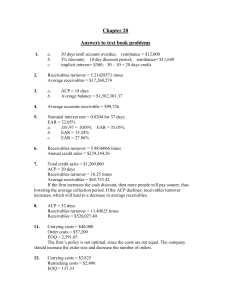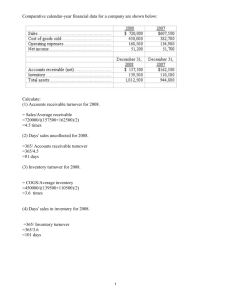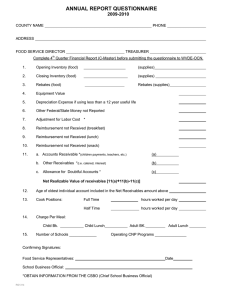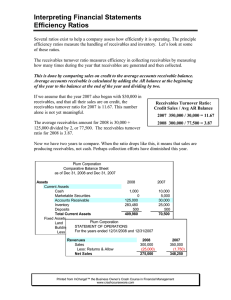CHAPTER 20 CREDIT AND INVENTORY MANAGEMENT
advertisement
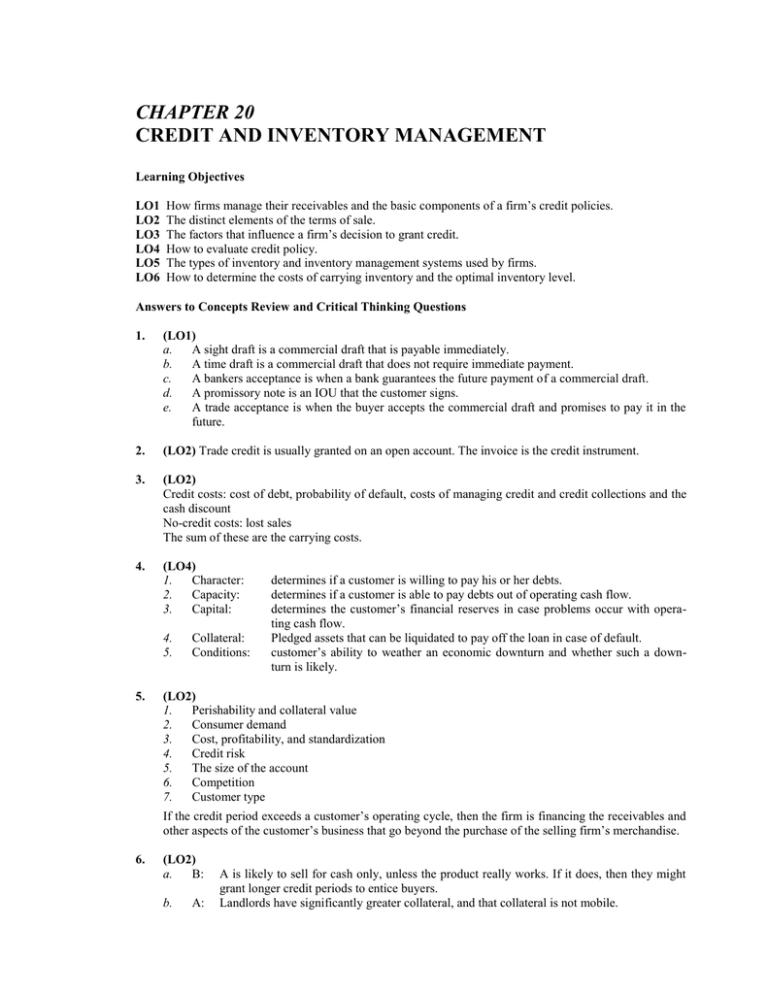
CHAPTER 20 CREDIT AND INVENTORY MANAGEMENT Learning Objectives LO1 LO2 LO3 LO4 LO5 LO6 How firms manage their receivables and the basic components of a firm’s credit policies. The distinct elements of the terms of sale. The factors that influence a firm’s decision to grant credit. How to evaluate credit policy. The types of inventory and inventory management systems used by firms. How to determine the costs of carrying inventory and the optimal inventory level. Answers to Concepts Review and Critical Thinking Questions 1. (LO1) a. A sight draft is a commercial draft that is payable immediately. b. A time draft is a commercial draft that does not require immediate payment. c. A bankers acceptance is when a bank guarantees the future payment of a commercial draft. d. A promissory note is an IOU that the customer signs. e. A trade acceptance is when the buyer accepts the commercial draft and promises to pay it in the future. 2. (LO2) Trade credit is usually granted on an open account. The invoice is the credit instrument. 3. (LO2) Credit costs: cost of debt, probability of default, costs of managing credit and credit collections and the cash discount No-credit costs: lost sales The sum of these are the carrying costs. 4. (LO4) 1. Character: 2. Capacity: 3. Capital: 4. 5. 5. Collateral: Conditions: determines if a customer is willing to pay his or her debts. determines if a customer is able to pay debts out of operating cash flow. determines the customer’s financial reserves in case problems occur with operating cash flow. Pledged assets that can be liquidated to pay off the loan in case of default. customer’s ability to weather an economic downturn and whether such a downturn is likely. (LO2) 1. Perishability and collateral value 2. Consumer demand 3. Cost, profitability, and standardization 4. Credit risk 5. The size of the account 6. Competition 7. Customer type If the credit period exceeds a customer’s operating cycle, then the firm is financing the receivables and other aspects of the customer’s business that go beyond the purchase of the selling firm’s merchandise. 6. (LO2) a. B: b. A: A is likely to sell for cash only, unless the product really works. If it does, then they might grant longer credit periods to entice buyers. Landlords have significantly greater collateral, and that collateral is not mobile. c. A: d. B: e. A: Since A’s customers turn over inventory less frequently, they have a longer inventory period, and thus, will most likely have a longer credit period as well. Since A’s merchandise is perishable and B’s is not, B will probably have a longer credit period. Rugs are fairly standardized and they are transportable, while carpets are custom fit and are not particularly transportable. 7. (LO5) The three main categories of inventory are: raw material (initial inputs to the firm’s production process), work-in-progress (partially completed products), and finished goods (products ready for sale). From the firm’s perspective, the demand for finished goods is independent from the demand for the other types of inventory. The demand for raw material and work-in-progress is derived from, or dependent on, the firm’s needs for these inventory types in order to achieve the desired levels of finished goods. 8. (LO5) JIT systems reduce inventory amounts. Assuming no adverse effects on sales, inventory turnover will increase. Since assets will decrease, total asset turnover will also increase. Recalling the Du Pont equation, an increase in total asset turnover, all else being equal, has a positive effect on ROE. 9. (LO5) Carrying costs should be equal to order costs. Since the carrying costs are low relative to the order costs, the firm should increase the inventory level. 10. (LO5) Since the price of components can decline quickly, Dell does not have inventory which is purchased and then declines quickly in value before it is sold. If this happens, the inventory may be sold at a loss. A part of the JIT system, Dell manufacturing plants will often have areas set aside that are for the suppliers. When parts are needed, it is a matter of going across the floor to get new parts. While this approach is valuable, it is difficult to implement. In fact, most computer manufacturers are trying to implement similar inventory systems, but it has been slow going for Dell’s competitors because the JIT system is a major change from the traditional inventory methods that the competitors are accustomed to. Solutions to Questions and Problems NOTE: All end of chapter problems were solved using a spreadsheet. Many problems require multiple steps. Due to space and readability constraints, when these intermediate steps are included in this solutions manual, rounding may appear to have occurred. However, the final answer for each problem is found without rounding during any step in the problem. Basic 1. (LO2) a. There are 30 days until account is overdue. If you take the full period, you must remit: Remittance = 350($140) Remittance = $49,000 b. There is a 1 percent discount offered, with a 10 day discount period. If you take the discount, you will only have to remit: Remittance = (1 – .01)($49,000) Remittance = $48,510 c. The implicit interest is the difference between the two remittance amounts, or: Implicit interest = $49,000 – 48,510 Implicit interest = $490 The number of days’ credit offered is: Days’ credit = 30 – 10 Days’ credit = 20 days 2. (LO1) The receivables turnover is: Receivables turnover = 365/Average collection period Receivables turnover = 365/34 Receivables turnover = 10.73529412 times And the average receivables are: Average receivables = Sales/Receivables period Average receivables = $38,000,000 / 10.73529412 Average receivables = $3,539,726.03 3. (LO1) a. The average collection period is the percentage of accounts taking the discount times the discount period, plus the percentage of accounts not taking the discount times the days’ until full payment is required, so: Average collection period = .65(10 days) + .35(30 days) Average collection period = 17 days b. And the average daily balance is: Average balance = 1,300($1,750)(17)(12/365) Average balance = $1,271,506.85 4. (LO1) The daily sales are: Daily sales = $17,300 / 7 Daily sales = $2,471.43 Since the average collection period is 36 days, the average accounts receivable is: Average accounts receivable = $2,471.43(36) Average accounts receivable = $88,971.43 5. (LO2) The interest rate for the term of the discount is: Interest rate = .01/.99 Interest rate = .0101 or 1.01% And the interest is for: 30 – 10 = 20 days So, using the EAR equation, the effective annual interest rate is: EAR = (1 + Periodic rate)m – 1 EAR = (1.0101)365/20 – 1 EAR = .2013 or 20.13% a. The periodic interest rate is: Interest rate = .02/.98 Interest rate = .0204 or 2.04% And the EAR is: EAR = (1.0204)365/20 – 1 EAR = .44585 or 44.585% b. The EAR is: EAR = (1.0101)365/45 – 1 EAR = .0849 or = 8.49% c. The EAR is: EAR = (1.0101)365/15 – 1 EAR = .277 or 27.7% 6. (LO1) The receivables turnover is: Receivables turnover = 365/Average collection period Receivables turnover = 365/33 Receivables turnover = 11.06060606 times And the annual credit sales are: Annual credit sales = Receivables turnover × Average daily receivables Annual credit sales = 11.06($42,300) 7. Annual credit sales = $467,863.64 (LO1) The total sales of the firm are equal to the total credit sales since all sales are on credit, so: Total credit sales = 8,200($430) Total credit sales = $3,526,000 The average collection period is the percentage of accounts taking the discount times the discount period, plus the percentage of accounts not taking the discount times the days’ until full payment is required, so: Average collection period = .60(10) + .40(40) Average collection period = 22 days The receivables turnover is 365 divided by the average collection period, so: Receivables turnover = 365/22 Receivables turnover = 16.591 times And the average receivables are the credit sales divided by the receivables turnover so: Average receivables = $3,526,000/16.591 Average receivables = $212,526.03 If the firm increases the cash discount, more people will pay sooner, thus lowering the average collection period. If the ACP declines, the receivables turnover increases, which will lead to a decrease in the average receivables. 8. (LO1) The average collection period is the net credit terms plus the days overdue, so: Average collection period = 30 + 7 Average collection period = 37 days The receivables turnover is 365 divided by the average collection period, so: Receivables turnover = 365/37 Receivables turnover = 9.86486 times And the average receivables are the credit sales divided by the receivables turnover so: Average receivables = $9,300,000 / 9.86486 Average receivables = $942,739.73 9. (LO4) a. The cash outlay for the credit decision is the variable cost of the engine. If this is a one-time order, the cash inflow is the present value of the sales price of the engine times one minus the default probability. So, the NPV per unit is: NPV = –$1,900,000 + (1 – .005)($2,015,000)/1.018 NPV = $69,474.46 per unit The company should fill the order. b. To find the breakeven probability of default, , we simply use the NPV equation from part a, set it equal to zero, and solve for . Doing so, we get: NPV = 0 = –$1,900,000 + (1 – )($2,015,000)/1.018 = .04 or 4% We would not accept the order if the default probability was higher than 4 percent. c. If the customer will become a repeat customer, the cash inflow changes. The cash inflow is now one minus the default probability, times the sales price minus the variable cost. We need to use the sales price minus the variable cost since we will have to build another engine for the customer in one period. Additionally, this cash inflow is now a perpetuity, so the NPV under these assumptions is: NPV = –$1,900,000 + (1 – .005)($2,015,000 – 1,900,000)/.018 NPV = $4,456,944.44 per unit The company should fill the order. The breakeven default probability under these assumptions is: NPV = 0 = –$1,900,000 + (1 – )($2,015,000 – 1,900,000)/.018 = .7026 or 70.26% We would not accept the order if the default probability was higher than 70.26 percent. This default probability is much higher than in part b because the customer may become a repeat customer. d. It is assumed that if a person has paid his or her bills in the past, they will pay their bills in the future. This implies that if someone doesn’t default when credit is first granted, then they will be a good customer far into the future, and the possible gains from the future business outweigh the possible losses from granting credit the first time. 10. (LO4) The cost of switching is the lost sales from the existing policy plus the incremental variable costs under the new policy, so: Cost of switching = $720(1,240) + $525(1,290 – 1,240) Cost of switching = $919,050 The benefit of switching is the new sales price minus the variable costs per unit, times the incremental units sold, so: Benefit of switching = ($720 – 525)(1,290 – 1,240) Benefit of switching = $9,750 The benefit of switching is a perpetuity, so the NPV of the decision to switch is: NPV = –$919,050+ $9,750/.0095 NPV = $107,265.79 The firm will have to bear the cost of sales for one month before they receive any revenue from credit sales, which is why the initial cost is for one month. Receivables will grow over the one month credit period and will then remain stable with payments and new sales offsetting one another. 11. (LO6) The carrying costs are the average inventory times the cost of carrying an individual unit, so: Carrying costs = (2,500/2)($7.5) = $9,375 The order costs are the number of orders times the cost of an order, so: Order costs = (52)($1,300) = $67,600 The economic order quantity is: EOQ = [(2T × F)/CC]1/2 EOQ = [2(52)(2,500)($1,300)/$7.5]1/2 EOQ = 6,713.17 The firm’s policy is not optimal, since the carrying costs and the order costs are not equal. The company should increase the order size and decrease the number of orders. 12. (LO6) The carrying costs are the average inventory times the cost of carrying an individual unit, so: Carrying costs = (300/2)($38) = $5,700 The order costs are the number of orders times the cost of an order, so: Restocking costs = 52($75) = $3,900 The economic order quantity is: EOQ = [(2T × F)/CC]1/2 EOQ = [2(52)(300)($75)/$38]1/2 EOQ = 248.15 The number of orders per year will be the total units sold per year divided by the EOQ, so: Number of orders per year = 52(300)/248.15 Number of orders per year = 62.86 or 63 times The firm’s policy is not optimal, since the carrying costs and the order costs are not equal. The company should decrease the order size and increase the number of orders. Intermediate 13. (LO6) The total carrying costs are: Carrying costs = (Q/2) CC where CC is the carrying cost per unit. The restocking costs are: Restocking costs = F (T/Q) Setting these equations equal to each other and solving for Q, we find: CC (Q/2) = F (T/Q) Q2 = 2 F T /CC Q = [2F T /CC]1/2 = EOQ 14. (LO4) The cash flow from either policy is: Cash flow = (P – v)Q So, the cash flows from the old policy are: Cash flow from old policy = ($86 – 47)(3,510) Cash flow from old policy = $136,890 And the cash flow from the new policy would be: Cash flow from new policy = ($88 – 47)(3,620) Cash flow from new policy = $148,420 So, the incremental cash flow would be: Incremental cash flow = $148,420 – 136,890 Incremental cash flow = $11,530 The incremental cash flow is a perpetuity. The cost of initiating the new policy is: Cost of new policy = –[PQ + v(Q – Q)] So, the NPV of the decision to change credit policies is: NPV = –[($88)(3,510) + ($47)(3,620 – 3,510)] + $11,530/.025 NPV = $147,150 Barry should proceed. 15. (LO4) The cash flow from the old policy is: Cash flow from old policy = ($150 – 130)(1,550) Cash flow from old policy = $31,000 And the cash flow from the new policy will be: Cash flow from new policy = ($154 – 133)(1,580) Cash flow from new policy = $33,180 The incremental cash flow, which is a perpetuity, is the difference between the old policy cash flows and the new policy cash flows, so: Incremental cash flow = $33,180 – 31,000 Incremental cash flow = $2,180 The cost of switching credit policies is: Cost of new policy = –[PQ + Q(v – v) + v(Q – Q)] In this cost equation, we need to account for the increased variable cost for all units produced. This includes the units we already sell, plus the increased variable costs for the incremental units. So, the NPV of switching credit policies is: NPV = –[($150)(1,550) + (1,550)($133 – 130) + ($133)(1,580 – 1,550)] + ($2,180/.0095) NPV = –$11,666.32 Codiac Corp should not switch. 16. (LO4) If the cost of subscribing to the credit agency is less than the savings from collection of the bad debts, the company should subscribe. The cost of the subscription is: Cost of the subscription = $750 + $6(500) Cost of the subscription = $3,750 And the savings from having no bad debts will be: Savings from not selling to bad credit risks = ($390)(500)(0.04) Savings from not selling to bad credit risks = $7,800 So, the company’s net savings will be: Net savings = $7,800 – 3,750 Net savings = $4,050 The company should subscribe to the credit agency. Challenge 17. (LO3) The cost of switching credit policies is: Cost of new policy = –[PQ + Q(v – v) + v(Q – Q)] And the cash flow from switching, which is a perpetuity, is: Cash flow from new policy = [Q(P – v) – Q(P – v)] To find the breakeven quantity sold for switching credit policies, we set the NPV equal to zero and solve for Q. Doing so, we find: NPV = 0 = –[($86)(3,510) + ($47)(Q – 3,510)] + [(Q)($88 – 47) – (3,510)($86 – 47)]/.025 0 = –$136,890 – $47Q + $1,640Q – $5,475,600 $1,593Q = $5,612.490 Q = 3,523.22 18. (LO3) We can use the equation for the NPV we constructed in Problem 17. Using the sales figure of 3,750 units and solving for P, we get: NPV = 0 = [–$88(3,510) – ($47)(3,750 – 3,510)] + [(P – 47)(3,750) – ($86 – 47)(3,510)]/.025 0 = –$308,880 – 11,280 + $150,000P – 7,050,000 – 5,475,600 $150,000P = $12,845,760 P = $85.64 19. (LO3) From Problem 15, the incremental cash flow from the new credit policy will be: Incremental cash flow = Q(P – v) – Q(P – v) And the cost of the new policy is: Cost of new policy = –[PQ + Q(v – v) + v(Q – Q)] Setting the NPV equal to zero and solving for P, we get: NPV = 0 = –[($150)(1,550) + ($133 – 130)(1,550) + ($133)(1,580 – 1,550)] + [(1,580)(P – 133) – (1,550)($150 – 130)]/.0095 0 = –[$232,500 + 4,650 + 3,990] + $166,315.79P – 22,122,000 – 3,263,157.90 $166,315.79P = $25,624,297.90 P = $154.07 20. (LO6) Since the company sells 700 suits per week, and there are 52 weeks per year, the total number of suits sold is: Total suits sold = 700 × 52 = 36,400 And, the EOQ is 500 suits, so the number of orders per year is: Orders per year = 36,400 / 500 = 72.80 To determine the day when the next order is placed, we need to determine when the last order was placed. Since the suits arrived on Monday and there is a 3 day delay from the time the order was placed until the suits arrive, the last order was placed Friday. Since there are five days between the orders, the next order will be placed on Wednesday Alternatively, we could consider that the store sells 100 suits per day (700 per week / 7 days). This implies that the store will be at the safety stock of 100 suits on Saturday when it opens. Since the suits must arrive before the store opens on Saturday, they should be ordered 3 days prior to account for the delivery time, which again means the suits should be ordered in Wednesday. 21. (LO6) The cash outlay for the credit decision is the variable cost of the engine. Since the orders can be one-time or perpetual, the NPV of the decision is the weighted average of the two potential sales streams. The initial cost is the cost for all of the engines. So, the NPV is: NPV = –$1,425,000 + (1 – .30)(125)($13,000)/1.019 + .30(125)($13,000 – 11,400)/.019 NPV = $2,849,185.22 The company should fill the order. 22. (LO2)The default rate will affect the value of the one-time sales as well as the perpetual sales. All future cash flows need to be adjusted by the default rate. So, the NPV now is: NPV = –$1,425,000 + (1 – .15)[(1 – .30)(125)($13,000)/1.019 + .30(125)($13,000 – 11,400)/.019] NPV = $2,208,057.44 The company should still fill the order.

